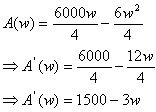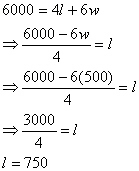
First we need to determine which equations it is we will need. Note that the problem tells us how much money we can spend and how much each fence component costs per foot. From this we can derive a cost function (which is the same as the perimeter).

We will also need, of course, the function we are trying to maximize which is the standard area equation for a rectangle.
The only problem with this equation is that it has too many variables. We only want to deal with a function of one variable. So we go back to the only other equation we have and see what that gives us. Indeed,

Now that we have a function of one variable we may employ techniques from Calculus to find critical points. Remember also that we need to establish boundary conditions on w. This can be achieved by looking at the cost function. First notice that the smallest l or w can be is zero. So, if l is zero how big is w? Manipulating the cost equation tells us that if l is zero then w=1000. So the domain for w is exactly [0,1000]. Notice that although you should always check the boundary points to find a global min or max these boundary conditions will yield a zero area. Not too practical. With this taken in to account it seems fair to reason that the critical point achieved from manipulating the first derivative will give us the desired solution.

We now set the acquired derivative equal to zero and solve.

To find the other dimension (l) we use the cost function derived earlier,

Since this is the only possibilty deduced by the first derivative
and the boundary conditions give us zero area the values w=500
and l=750 maximize the area.